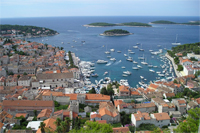 Hvar, which lies south of Brac, may be the quintessential Croatian island. Endless terraces of vineyards and olive groves surrounded by a translucent cobalt sea and wrapped in a scent of lavender fields.
Hvar, which lies south of Brac, may be the quintessential Croatian island. Endless terraces of vineyards and olive groves surrounded by a translucent cobalt sea and wrapped in a scent of lavender fields.
The island holds the record for the most number of sunny days a year, but there is plenty of shade for those who prefer it. Its heart is the town of Hvar, which curls around a row of coves and is adorned with Venetian architecture, a knot of narrow streets and a hilltop fortress. Its seafront features a Franciscan monastery with its century-old cypress garden and over two hundred pristine Greek and Roman coins.
A lot could be said about the cultural traditions of Hvar. The oldest relief of a ship in Europe was found here, and the theatre dating from 1612 is said to be the first to admit commoners. There is also the Renaissance Cathedral with its original tower, rich treasury and many paintings by old masters. Several late Gothic buildings have been preserved on one of the largest squares, the most prominent among them being the unfinished palace of the Renaissance poet Petar Hektorovic.
Each of the island's towns has an air of authenticity. Stari Grad (Old Town) on Hvar was founded in 385 BC as the Greek colony of Pharos. It is situated at the deepest end of the 6km long bay. You can see the remains of the Greek fortifications and the fortified castle with its pond and arcades. Vrboska lies at the deepest end of a protected bay. The rows of stone houses, linked by a series of bridges along both coasts, create a harmonious architectural whole.